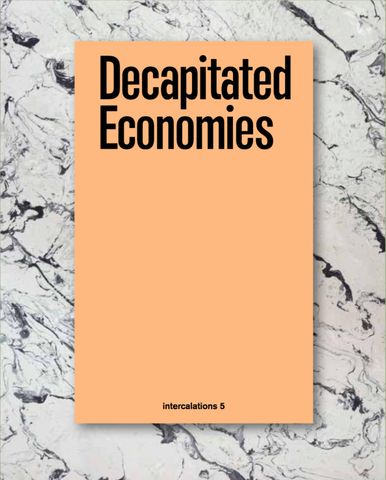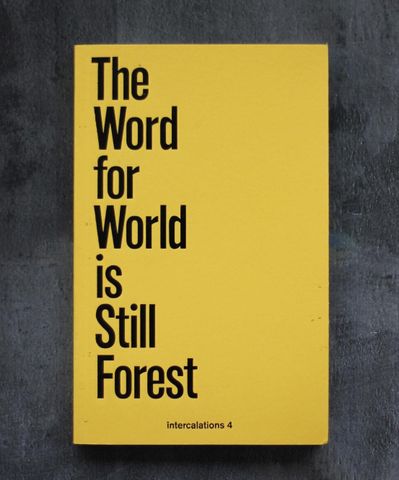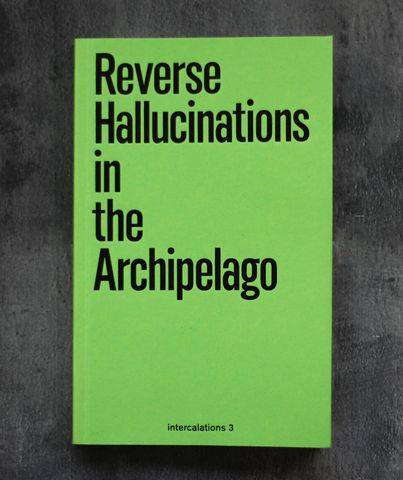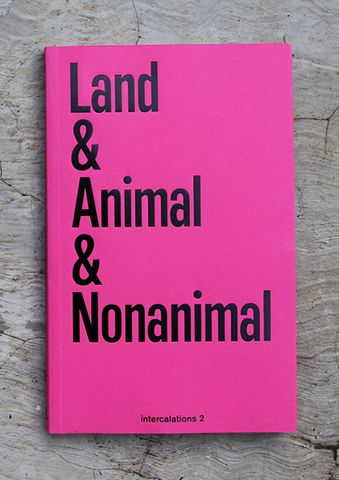intercalations: paginated exhibition

The intercalations: paginated exhibition series is an experimental foray exploring the structure of the book as a potential curatorial space. As the reader-as-exhibition-viewers move through these books-as-exhibition, they discover that the erratic intercalations of the Anthropocene invite new forms of literacy, visuality, inquiry and speculation that are, in the words of the author Clarice Lispector, less promiscuous than they are kaleidoscopic.
This six-part series was developed by Anna-Sophie Springer & Etienne Turpin for the Anthropocene Project as a commission of the Synapse Curators' Network. Its volumes are published as printed matter paperback books, as well as web-based, open-access publications. They provoke questions about the validity of seeming categorical binaries such as culture and nature, human and non-human, subject and object, book and exhibition. The six volumes are leading their reader-as-exhibition viewers along a series of bifurcating trajectories where curators, artists, scientists, activists, storytellers and writers pose urgent questions about contemporary struggles for both the cultivation, preservation and reformation of biomes and their organisms, for land rights and territorial negotiations, and for possible new social, political and more-than-human life forms.
Edited by Anna-Sophie Springer and Etienne Turpin
intercalations: a paginated exhibition series is published in cooperation with K. Verlag, made possible by Schering Stiftung

These Birds of Temptation
Volume 6, 2022
... a queer refrain, populated with both acoustical lines of flight and the sorrows of captivity, wherein the reader-as-exhibition-viewer learns that the adventure of ornithology is as preoccupied with the evolutionary meaning of allopreening among avifauna as it is with their taxonomical domination.
More about the book

Decapitated Economies
Volume 5, 2022
... a book of provocations wherein the reader-as-exhibition-viewer learns that the “head,” despite its interminable rule over the body, necessarily underestimates the sophistication of corporeal desire when such desire is unleashed in accord with the principles of a general economy.
More about the book

The Word for World is Still Forest
Volume 4, 2017
... creates a space for the reader-as-exhibition-viewer to consider how forests may be seen not only for their trees, but also how they can enable experiences of elegance, affirmation and creation for a multitude of creatures; in response to their violent destruction, which characterizes the Anthropocene, these pages traverse various woodlands by way of their semiotic, socio-political, historical and epistemic incitements in order to reveal how practices of care, concern and attention also enable humans to inhabit and flourish in this world as forest.
More about the book

Reverse Hallucinations in the Archipelago
Volume 3, 2017
… unfolds an itinerant encounter with nineteenth-century European naturalists in the Malay Archipelago, where the theory of evolution by natural selection emerged alongside less celebrated concerns about mass extinction and climate change; by re-considering the reverse hallucinatory condition of colonial science in the tropics—how scientists learned to not see what was manifestly present—the reader-as-exhibition-viewer may exhume from the remains of this will to knowledge an ethical conviction of particular relevance for confronting forms of neocolonization in the Anthropocene.
More about the book

Land & Animal & Nonanimal
Volume 2, 2015
… a lively ensemble arguing that the meaning of the Anthropocene is less a geological re-formation than it is trans-formation of modern-colonial categories of live and non-life; once exposed to some of the parameters defining this transition, the reader-as-exhibition-viewer may begin to discern erratic rhythms generated by the creatures of nonconformity that inhabit, with their violence, struggles and love, the vast, biochemic wanderer called Earth.
More about the book

Fantasies of the Library
Volume 1, 2015
... an unruly sequence of pages wherein the reader-as-exhibition-viewer learns, rather surprisingly – but with growing conviction – that the library is not only a bibliological imaginary, but that its curatorial potential is also a fertile territory for the exploration of paginated affairs in the Anthropocene.
More about the book